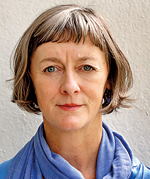Diversity important for Sri Lanka to grow as a creative economy, says expert

Shelagh Wright
The abundance of vision and artistic talent in Sri Lanka comes as no surprise to anyone who has interacted with local culture. Our potential to position our island as a leading creative force can only be realised if the creative industries themselves come together as a cohesive and sustainable economy.
This is the basis for the concept of the creative economy, as explained by an expert on the creative economy Shelagh Wright.
Shelagh’s work as a consultant and policy advisor for the creative economy has taken her across the globe, as part of many eminent organisations and campaigns such as the think-tank Demos and the United Kingdom (UK) government’s ‘Creative Britain’ strategy. She also contributes to international policy development for the creative economy by engaging with national governments and agencies.
Shelagh was in town to head the Creative Economies Policy Forum on Friday, November 9, organised by the Academy of Design (AOD) and Sri Lankan Design Festival (SLDF) in collaboration with the British Council Sri Lanka. The forum was to discuss and map out a national policy for harnessing creative industries in the island.
Creative economy is the fastest growing sector in both the UK and globally. The United Nations estimates that the global creative economy is worth 2,250 billion dollars and that it employs nearly 30 million people today, and rising.
Shelagh takes the UK as an example, where in particular there’s been a growing focus on the value placed in the creative economy. “The creative economy tends to be lots of quite small businesses, so it’s quite hard to see very often, even though it’s right there in between the cracks.Trying to make it more tangible is a lot of work.” she explains.
Globally, the British Council has been very committed towards creative economic development. In Sri Lanka, the British Council felt there was a growing potential towards a creative economic development. Shelagh points out there are several upcoming institutes like the AOD and SLDF, as well as programmes to support young businesses like British Council’s Creative Enterprise Program.
The forum focused on topics, such as what each sector can do for itself in terms of quick wins to gain profile, as well as several policy issues. Shelagh points out that some of the things to look at are if there’s a talent pool that’s coming through to grow this area, and factors of the physical environment to do with financial backing, government support, etc.
“So some of it is quite high-level, long term stuff, like developing the education system in a way that is much more responsive to developing curiosity and creativity and those kinds of skills that can be so vital for the future,” she explains.
The sector must also think about whether or not it collectively wants to start something here and start campaigning around for creative education and talent development, to have a coherent voice made up of diverse representatives to engage with government.
That diversity is important, and Shelagh believes that while Sri Lanka clearly has strengths in particular areas in creative economy such as design and fashion, it needs a richer cultural mix to really evolve and grow across wider diverse sectors. This would include galvanising other areas like music, film, animation, architecture, etc.
Part of the problem with the creative economy in her experience is that it tends to be quite invisible as a large sector. That is one of the issues they’ve faced in the UK as well, as the focus tends to be on London and the metropolitan areas. But the reality is that the creative economy is varied geographically, culturally and socially.
“There are different pockets and centres where there are different kinds of expertise and activities going on, and I think one of the things we have to do is understand that it isn’t all about Colombo, the same way it’s not all about London, and then really build those relationships,” she explains.
Shelagh believes the networking sector plays a key role, and that creating recognition, visibility, and the right kind of connections would cater to a collaborative environment with access to supply chains and wider markets that would help businesses to thrive and grow.
She hopes the forum will be the beginning of an action plan. It should contain “just some idea of the things that the sector can do itself, the big issues they want to work on, engaging with people, bringing people into the conversation, and that there will be a commitment to it,” she tells us.
“There’s a bit of putting something in to get a bigger return, knowing that if you commit in that way then collectively everyone gets much better options and possibilities.”
Ideally they’re looking for collaborations or a small taskforce of people who are committed to taking this forward and who will agree to meet regularly to ensure that action is being taken.
“I think you have to work with really tangible options, to do small simple things that help move things forward. At the same time, you must have a bigger vision in the sense of where Sri Lanka wants to be in 20 years’ time and how it can grow,” she says.
As Shelagh puts it, there is no shortage of talent in Sri Lanka and there’s definitely a very strong sense of pride, heritage and culture. The possibility to make something significant happen is within our grasp, in a very unique, futureproof industry based on human talent where machines cannot do the job. The commitment and collaboration is up to us to forge.


